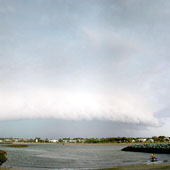|
|
Climate and Terrain - Attribute UncertaintyAttributes were visually assessed for reasonable spatial patterns and checked to ensure all values fell within reasonable limits. The national 9-second DEM is the primary source data layer for the stream network and many of the attributes. Attribute accuracy is thus dependent on the DEM’s accurate representation of height and surface drainage pathways. The standard elevation error of Version 2 of the DEM was found to vary between about 7.5 and 20m but may be as high as 200m in very steep or complex terrain[1].
Quick factsA similar assessment of version 3 of the DEM has not yet been undertaken but errors are probably of a similar magnitude. A comparison of derived catchment areas provides a guide to the accuracy of surface drainage pathways and catchment boundaries. Catchment areas computed from the DEM were found to be different from those derived independently for 328 stream gauging stations compiled for the NLWRA[2] by less than 2.5% on average with more than one third of values differing by less than 1%. For 11 gauging stations, catchment area differed by more than 10% up to a maximum value of 29%. Climate estimates are derived from long-term monthly mean climate surfaces with relative standard errors of about 10% for rainfall and radiation and 0.2 to 0.4 degrees C for maximum and minimum temperature[1]. Errors in elevation values from the DEM also affect climate estimates. The rainfall erosivity has a quoted relative error of approximately 20%[3]. Errors and uncertainty from a range of sources, including that associated with the specification of soil parameters, the annual climate surface coefficients and elevation errors, affect the accumulated soil water surplus used to represent run-off. The water balance model employed is a gross simplification of the processes of run-off generation. In particular, the aggregation of individual rainfall events to a weekly time step will influence the predicted surplus. The accumulated soil water surplus provides an estimate of the potential volume of water that may be available for stream flow. However, many other factors not considered here including wetland or groundwater storage and transmission losses, will influence measured discharge. Nevertheless, Stein (in prep.) found the simple water balance provided a reasonable estimate of the regional scale water balance when compared with measured discharge for about 330 stream gauging stations with unimpaired flow and catchment areas up to 2000 km2 compiled for the NLWRA by Peel et al. (2000)[2]. References
Last updated: 22 March 2013 This page should be cited as: Department of Environment, Science and Innovation, Queensland (2013) Climate and Terrain - Attribute Uncertainty, WetlandInfo website, accessed 8 May 2025. Available at: https://wetlandinfo.des.qld.gov.au/wetlands/what-are-wetlands/definitions-classification/classification-systems-background/methods/climate-terrain-uncertainty.html |

 — Department of the Environment, Tourism, Science and Innovation
— Department of the Environment, Tourism, Science and Innovation


